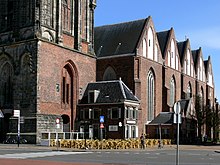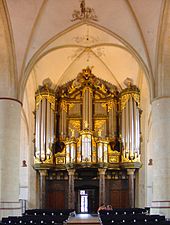Martinikerk (Groningen)


The Reformed Martinikerk is the oldest church in the Dutch city of Groningen .
history
Several previous buildings of the Martinikerk have been archaeologically proven. A wooden church was built around 800, which was probably replaced by a tufa building in the early 10th century .
In the first half of the 13th century , a cruciform basilica in Romano-Gothic style was built in its place, made of brick , the outstanding characteristic of which is the domical vault . This church is represented on the city seal from 1245.
In the early 15th century , a thorough high Gothic renovation of the entire building began. In the 1450s the choir was expanded to become a basilican ambulatory choir . The nave was expanded as a hall church . As with three Bremen churches, the nave was provided with transverse roofs. Their pediments wear pointed arch dazzle with white rendered backgrounds, typically as usual for the Baltic region. In 1468 the old church tower collapsed and the nave was damaged. The nave was extended to the west and a new tower was built between 1469 and 1482. The church tower ( Martini tower ) can be climbed.
In 1559 the Martinikerk became the bishop's church of the diocese of Groningen . After the capture of the city of Groningen by Maurice of Orange on July 22, 1594 the diocese was dissolved. The altars and images of saints have been removed from the Martinikerk; the church was converted into a reformed church. In 1611 the commander of the Groningen state fort, Johannes Corputius, was buried in the church's choir. Corputius belonged to the Calvinist faith and had fought for Moritz von Oranien and Wilhelm Ludwig von Nassau in the Eighty Years' War .
In the 17th century , the roof landscape of the church was heavily changed during renovations. This measure was also reversed in the 1970s due to structural defects.
organ
The first construction phase of the famous Martinikerk organ dates back to 1450 and 1482. It owes its current shape to the expansion by Arp Schnitger (1692), his son Franz Caspar Schnitger (1729) and Albertus Antonius Hinsz (1740).
use
The Martinikerk is mainly used on weekdays by the university . On Sundays and public holidays, it is still used for worship purposes.
Web links
- Church website (Dutch)
- Ronald Stenvert, Chris Kolman, Ben Olde Meierink, Margreet Tholens…: Monuments in Nederland , 12 volumes (1996–2006), available as PDF for free download from the digital library voor de Nederlandse lettersen → Volume Groningen
- P. 22 - Choir as an example of high Gothic in the chapter Stijl en Verschijningsvoormen
- P. 99 ff. - Description of the church
- Interview with Ms. de Haan from the Martinikerk on YouTube
Coordinates: 53 ° 13 ′ 9 ″ N , 6 ° 34 ′ 6 ″ E
Footnotes
- ↑ Building description of the Rijksdienst voor Archeologie, Cultuurlandschap en Monumenten , accessed on October 31, 2018.

